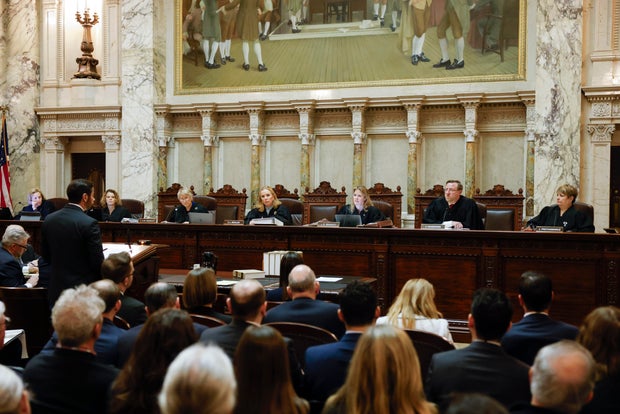Republican Sen. Ron Johnson won reelection in 2022 in Wisconsin by just over 25,000 votes — the latest slim-majority victory in the state, which gave its 10 Electoral College votes to former President Donald Trump in 2016 with a victory of 22,000 votes and then flipped to President Joe Biden in 2020, who won the state by around 20,000 votes.
But despite the state’s history of winning elections on the margins, Republicans dominate the state legislature, with 64 Republicans and 35 Democrats in the Wisconsin Assembly. The groundbreaking ruling in late December by the Wisconsin Supreme Court throwing out the GOP-drawn district lines could threaten that control — and change the state’s political landscape.
Though Republicans told the Milwaukee Journal Sentinel that the U.S. Supreme Court will have the “last word” on the matter, now hinting at taking the fight to defend Wisconsin’s electoral maps, which have consistently favored the GOP, to the higher court.
“We will pursue all federal issues arising out of the redistricting litigation at the U.S. Supreme Court,” Assembly Speaker Robin Vos said in a statement to the Milwaukee Journal Sentinel following the state Supreme Court’s decision.
Ruthie Hauge/The Capital Times via AP
The 4-3 ruling, issued Friday, deemed the current GOP-drawn lines unconstitutional and cites a violation of the state constitution’s requirement of “contiguous territories” in districts. Set to be enforced in March 2024, the revised map will put all 132 state lawmakers up for reelection in a pivotal year, providing Democrats with an opportunity to challenge the Republican stronghold on the state’s legislature.
With a potential shift to a more evenly divided legislature, the new map could hold implications for key issues such as abortion, previously rejected by Republicans for inclusion on the 2024 ballot.
Nicole Safar, executive director at Law Forward, a nonprofit law firm representing the 19 Democratic voters in the lawsuit filed against the current map, said tossing the gerrymandered map will give voters more of a voice in the legislative process.
“I think in the next legislative session in 2025 and 2026, we will see a different kind of ability for the citizens to impact the policies that our legislature makes. We’ll see real organizing, lobbying and campaigning around things like access to abortion, gun safety and public education,” Safar said.
The lawsuit was filed in August, shortly after state Supreme Court Justice Janet Protasiewicz was sworn in, which tilted the Wisconsin Supreme Court from a conservative to a liberal majority. The race was the most expensive state Supreme Court election in American history, with Democrats spending over $50 million. In television advertisements, Protasiewicz called the maps “unfair” and “rigged” and spoke about her support of abortion rights.
Writing the dissent on the lawsuit, Chief Justice Annette Ziegler, a conservative, drew on Protasiewicz’s past statements. Ziegler argued that liberals were only hearing the gerrymandering case due to their current majority.
There “appears to be evidence of a partisan and political, rather than a reasoned and restrained, approach, and thus departs from the constitutional role of the judiciary,” Ziegler wrote.
Republicans contended that the redesigned map would lead to the creation of more Democrat-friendly districts before the 2024 election and had called for Protasiewicz to recuse herself from the case.
Speaker Vos even threatened impeachment if Protasiewicz refused. However, the Republican leader later stated during a news conference in October that they would temporarily drop impeachment charges and appeal any decisions to the U.S. Supreme Court if the state Supreme Court ruled on Republican-drawn maps and other conservative causes.
Now that the state Supreme Court has ruled to toss the political map, the state legislature and Wisconsin’s Democratic Gov. Tony Evers are expected to agree on a new map.
If an agreement can’t be reached, the state’s Supreme Court will step in and consider maps based on the partisan makeup of the state, as per Justice Jill Karofsky’s opinion.
Evers, who has largely relied on his veto abilities to block the Republicans’ agenda throughout his tenure, said in a statement: “It’s clear to me that a Republican-controlled Legislature that has consistently gerrymandered itself into comfortable, partisan majorities for more than a decade is incapable of preparing fair, nonpartisan maps deserving of the people of this state. I agree with the Court’s determination that these maps are unconstitutional because the districts lack contiguity. Wisconsin is a purple state, and I look forward to submitting maps to the Court to consider and review that reflect and represent the makeup of our state. And I remain as optimistic as ever that, at long last, the gerrymandered maps Wisconsinites have endured for years might soon be history.”
According to Mark Gaber, senior director at the Campaign Legal Center, a nonpartisan group that seeks to curb partisanship in redistricting, a new map will likely not heavily favor either Republicans or Democrats.
“Wisconsin is a politically divided state with very close elections, with down-ballot races being even closer,” Gaber said.
And while Democrats are celebrating the redrawing of the state’s district lines, Gaber said the ruling should be viewed as a win for both parties because the new map will be “more representative of the true electorate,” which he noted as deeply purple.
